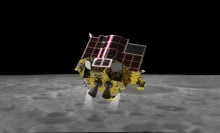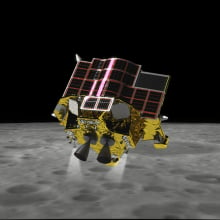When SpaceX rolls Starship to the launchpad this year for its third trial, the company will begin testing the spacecraft's ability to transfer super-chilled rocket fuel in space.
NASA is depending on billionaire Elon Musk's rocket company to ferry astronauts to the lunar surface for the Artemis III and IV moon missions under a $4.2 billion contract. To do that, SpaceX first has to master how to refuel a Starship in low-Earth orbit, after it has already blasted off the planet. The tricky concept is known as "cryogenic propellant transfer" — something never done before in microgravity.
NASA's plan to return astronauts to the moon for the first time in a half-century involves its own Orion spacecraft, but also SpaceX's Starship. In a sort of space relay, Orion would fly the crew to lunar orbit, and Starship would complete the final leg of the journey by meeting up with the astronauts in space and landing them on the surface. The "baton" could be passed at a yet-to-be-built moon-orbiting space station, or directly from one spacecraft to another.
The U.S. space agency has promised Artemis III will put a woman and person of color on the moon for the first time. But given that Starship has attempted spaceflight twice so far, each time ending minutes after liftoff with an explosion, it's perhaps unsurprising NASA just announced the moon-landing mission will be delayed at least a year to 2026.
"They're making tremendous progress in Boca Chica with their test flights," said Amit Kshatriya, NASA's Moon to Mars deputy associate administrator, referring to SpaceX's private spaceport in South Texas. "But it's extremely challenging to some of the propellant transfer and other goals that they have in order to make that Earth departure sequence work for us."
Why does NASA want a propellant depot in space?
NASA and commercial partners are interested in space fuel stations because they could allow spacecraft to travel longer and farther into the solar system. Future missions could use ice on the moon to make propellant by splitting water molecules into hydrogen and oxygen. If engineers can figure out how to store super-cold liquids in space, whether they are launched from Earth or produced somewhere else, it could make a long-term stay on the moon possible and even support distant missions to Mars.
NASA has invested $370 million in over a dozen U.S. companies to develop the technology needed to store and transfer rocket fuel in space. That funding includes $53 million for SpaceX to demonstrate a propellant transfer, from tanker to ship, in orbit.
The U.S. space agency has chosen to use private vendors for moon landers to buy down the technical risks and costs of the Artemis program, which seeks to use the moon as a springboard for eventual missions to Mars. SpaceX was the first selected, and Blue Origin, billionaire Jeff Bezos' rival space company, was awarded the contract for Artemis V, a crewed mission slated for no earlier than 2029.

SpaceX's 400-foot-tall rocket and spacecraft, known collectively as Starship, are designed to carry immense cargo and numerous people into deep space. Starship runs on 10 million pounds of liquid methane and oxygen, but the rocket consumes much of that fuel just to escape the firm grasp of Earth's gravity.
How would propellant transfer in orbit work?
To make the rest of the quarter-million-mile journey to the moon, Starship would need to top off its tank. The plan is for SpaceX to send up tanker versions of Starship into low-Earth orbit, establishing a fueling depot in space. A passenger version of Starship would dock at a tanker, fill up, and then complete the rest of the moonbound flight.
Blue Origin will also rely on orbital refueling.
"Propellant transfer in orbit sounds complex and scary — it seems like this big, nebulous thing — but when you really break it down into the various pieces, we've actually achieved almost all of the complex parts already on our operational programs now," said Jessica Jensen, SpaceX's vice president of customer operations and integration.

Starship's third orbital test flight
NASA, on the other hand, seems more daunted by the obstacles that lie ahead. Getting the choreography down for a dual launch campaign of Orion and Starship will be a "significant coordination challenge," Kshatriya said.
SpaceX plans to conduct a preliminary test in orbit this February, attempting to transfer 11 tons, or 10 metric tons, of liquid oxygen between tanks contained within Starship. It's a first step toward the eventual goal of transferring propellant between two separate ships in space.
But part of what has made orbital refueling seem hazy to outsiders is the mystery surrounding just how many launches will be needed to transport the propellant to a space tanker. Competitor Blue Origin suggested SpaceX's proposal would require 16 consecutive launches. Musk told a Washington Post reporter on X, then known as Twitter, that figure was "extremely unlikely," and it would probably fall somewhere between four and eight launches.
During an Artemis teleconference with reporters this week, Jensen estimated "10-ish," after NASA administrator Bill Nelson pressed her to provide a number.
SpaceX confidence in rapid refueling
Regardless of how many successive launches are necessary for the operation, SpaceX officials feel confident based on their track record. Though rapid refueling may "seem very intimidating," SpaceX has already proven it can handle several launches within hours of each other for its Falcon 9, the workhorse rocket that regularly lifts satellites to orbit.
The company has even proven it can turn around and launch from the same launchpad within a matter of days.

Furthermore, Jensen assured that SpaceX has experience with many of the steps involved in propellant transfer, such as rendezvous and docking maneuvers. Its Dragon spacecraft has docked more than 30 times at the International Space Station, flying 250 miles above Earth.
"Everything we've learned, from the sensors we use, the algorithm we use for the rendezvous, from pulling back — we're going to leverage all of that in having two Starships dock together," she said.































